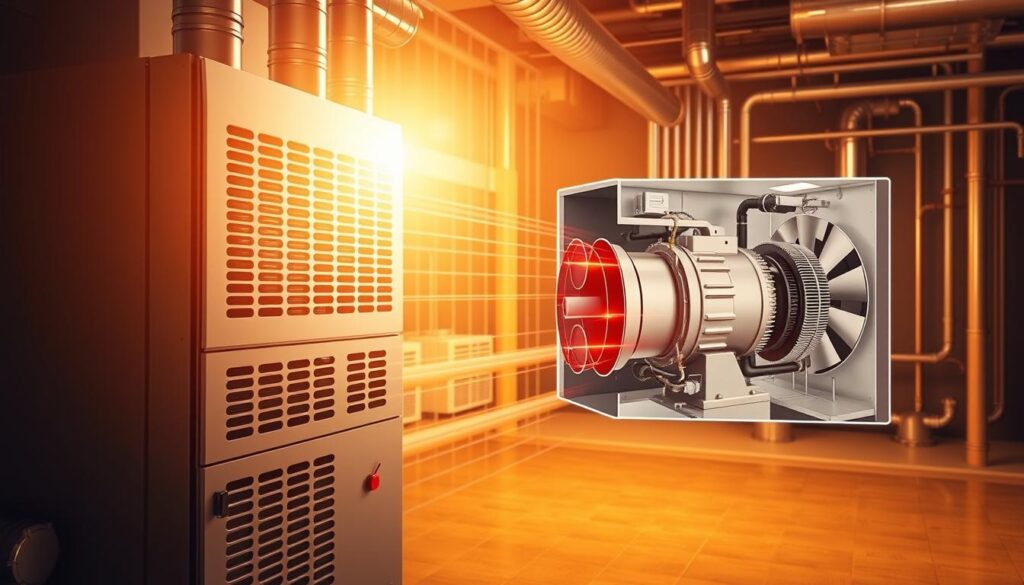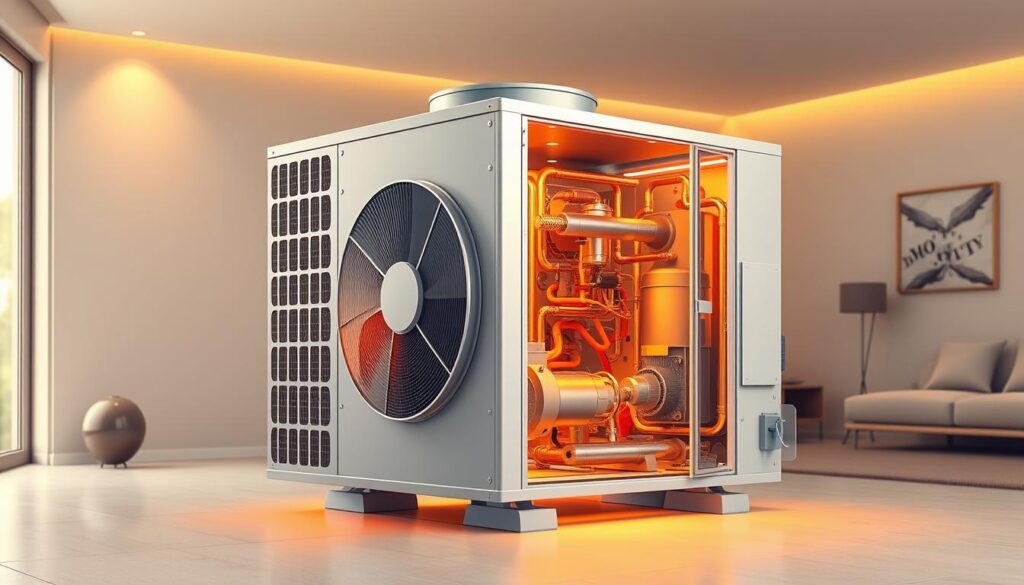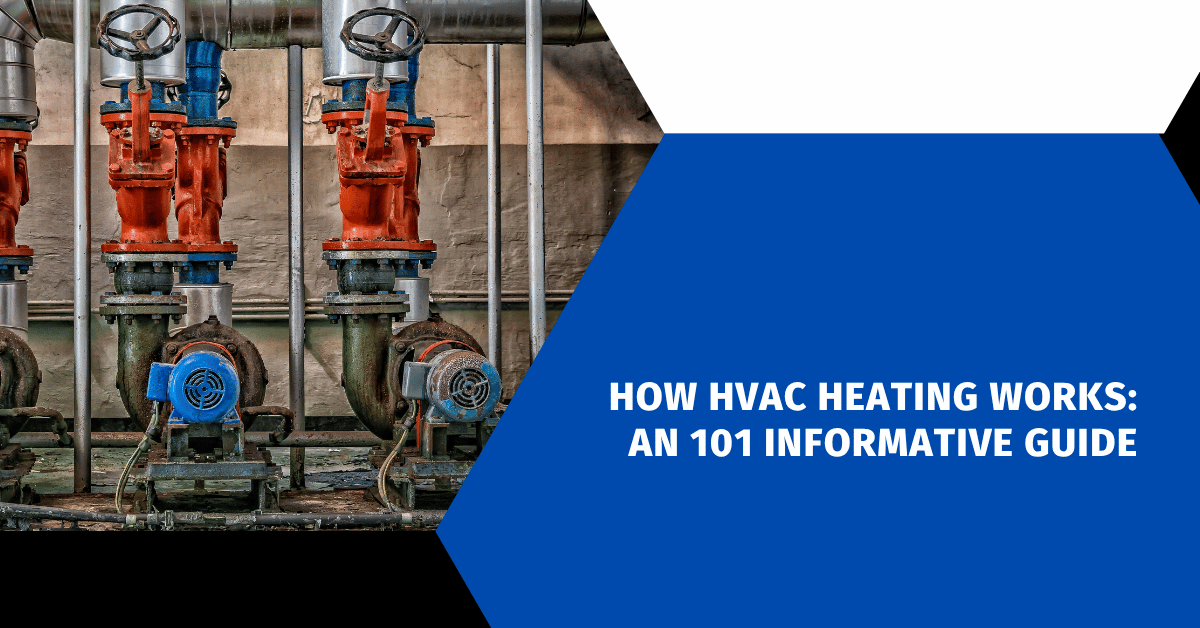Affiliate Disclosure
HVAC Guide Guys is a participant in the Amazon Services LLC Associates Program, an affiliate advertising program designed to provide a means for sites to earn advertising fees by advertising and linking to Amazon.
How HVAC Heating Works? Ever wondered how your home stays perfectly comfortable in cold winters and hot summers? What magical system keeps your living space at just the right temperature without you lifting a finger?

HVAC system operation is a complex yet fascinating process. It goes far beyond simple temperature control. Your home’s heating, ventilation, and air conditioning system is a sophisticated network of components. It’s designed to create the perfect indoor environment.
Understanding how HVAC heating works can help you make informed decisions. Modern HVAC systems are technological marvels. They balance comfort, energy efficiency, and advanced climate control.
Key Takeaways
- HVAC systems regulate indoor temperature through complex mechanical processes
- Proper maintenance can extend system lifespan to 15-20 years
- Energy efficiency is a critical factor in modern HVAC design
- Regular inspections can prevent costly system failures
- Smart technology is transforming home heating solutions
Table of Contents
Understanding HVAC System Fundamentals
Your home’s comfort comes from a network of parts working together. HVAC systems control temperature, airflow, and air quality. They make your living space comfortable.
Today’s HVAC systems are advanced machines. They do more than just heat and cool. They keep your home comfortable all year.
Key Components of HVAC Systems
Every HVAC system has important parts that work together:
- Heating units (furnaces or heat pumps)
- Cooling units (air conditioners)
- Air distribution networks
- Ventilation systems
The Role of Thermostat Controls
Thermostat controls are the brain of your HVAC system. They watch and adjust indoor temperatures. Smart thermostats even learn your habits to save energy.
| HVAC Component | Primary Function | Energy Impact |
|---|---|---|
| Furnace | Generate Heat | 40-50% of Energy Use |
| Air Conditioner | Cool Indoor Space | 30-40% of Energy Use |
| Thermostat | Temperature Regulation | 10-20% Energy Savings |
Basic Operating Principles
Learning about HVAC systems shows how they work together. They move air and control temperature. This keeps your home at the right comfort level.
“An efficient HVAC system is like a well-choreographed dance, moving air precisely where and when it’s needed.” – HVAC Engineering Experts
Knowing these basics helps you see the complexity of your home’s climate control.
How HVAC Heating Works: Core Mechanisms
Knowing how HVAC heating works is key for homeowners who want comfort and save energy. The furnace starts by turning fuel into warmth for your whole home.
The main steps in heating are:
- Thermostat signals the heating system to activate
- Burner delivers fuel to the heat exchanger
- Heat exchanger generates thermal energy
- Blower circulates warm air through ductwork
Most homes use gas-powered systems for heating, making up over 70% of installations. When your thermostat sees a lower temperature, it tells the furnace to start heating.
“The heart of HVAC heating lies in its ability to transform fuel into comfortable, consistent warmth throughout your living space.”
Flue pipes are vital for ventilation, safely removing harmful gases like carbon monoxide. The blower is key, moving warm air to rooms for even heating.
Today’s HVAC systems aim to save energy. They use new tech to cut energy use by up to 50% compared to old systems. This means more comfort and less cost for you.
Explore Our HVAC Shop
Looking for top-rated HVAC tools, parts, and accessories? Visit our shop and find the perfect solution for your needs.
Visit the ShopEssential Components of Heating Systems
Your home’s heating system is made up of many important parts. They work together to keep you warm and cozy. Knowing about these parts helps you take better care of your HVAC system. It also helps you spot problems early on.
The Heart of Heating: Furnace and Heat Exchanger
The furnace starts the heating process with the heat exchanger. This key part changes fuel energy into warm air. Furnaces, often found in utility rooms or basements, use natural gas or propane for heat.
The heat exchanger safely moves thermal energy. It makes sure harmful gases don’t mix with the air you breathe.
- Located in garage, attic, or basement
- Powered by fossil fuels like natural gas
- Converts fuel energy into usable heat
Air Distribution: Blower Motors and Circulation
The air handler is vital for spreading warm air around your home. Blower motors push the air through ducts, making sure it’s evenly distributed. Today’s systems have variable-speed blowers.
These blowers adjust the air flow for better efficiency and comfort.
“Proper air circulation is the key to maintaining consistent home temperatures.” – HVAC Expert
Precision Temperature Control
Thermostat control systems are the brain of your heating system. They watch the indoor temperature and turn the furnace on or off as needed. Smart thermostats can even learn your preferences and save energy.
- Monitor indoor temperature
- Activate heating systems automatically
- Provide energy-efficient programming
Types of HVAC Distribution Systems
It’s important to know about different HVAC systems for a comfy home. The design of your ductwork is key to good heating and cooling.
- Forced-Air Systems: Common in homes
- Gravity Systems: Old-school heating method
- Radiant Systems: Heats spaces directly
“Effective air distribution is the heart of maintaining consistent indoor comfort.” – HVAC Engineering Professionals
The design of your ductwork affects how well your system works. Round ducts are better at moving air than square ones. They cut down on air resistance and heat loss.
| Distribution System | Efficiency | Installation Complexity |
|---|---|---|
| Forced-Air | High | Moderate |
| Gravity | Low | Simple |
| Radiant | Very High | Complex |
How well your HVAC system works depends on where you put the ducts. Experts usually put ducts in basements, attics, and crawl spaces. This helps save space and energy.
Explore Our HVAC Shop
Looking for top-rated HVAC tools, parts, and accessories? Visit our shop and find the perfect solution for your needs.
Visit the ShopForced-Air Heating: The Most Common Method
Forced-air heating is the most common heating solution in North American homes. Almost 60% of single-family homes use it. This system heats your home quickly and efficiently.
Forced-air systems are known for their versatility and performance. They offer many benefits that make them a popular choice for homeowners:
Benefits of Forced-Air Systems
- Rapid heat distribution across all rooms
- Compatibility with central air conditioning
- Lower installation costs compared to radiator systems
- Reduced risk of toxic fumes and fire hazards
- Improved indoor air quality
Ductwork and Airflow Patterns
Good ductwork design is key to a forced-air system’s success. The blower pushes heated air through metal ducts. This ensures your home stays warm.
“A well-designed ductwork system is the backbone of efficient home heating” – HVAC Engineering Experts
Temperature Control Efficiency
Modern forced-air heating systems are very energy efficient. They have AFUE ratings from 80% to 100%. This means they save a lot of energy.
- High-efficiency models have AFUE ratings over 90%
- Regular maintenance keeps energy use low
- Changing filters can also cut energy costs
Choosing a well-designed forced-air heating system brings many benefits. You’ll enjoy consistent comfort, better air quality, and lower energy bills all winter.
Heat Pump Systems and Their Operation

Heat pumps are a new way to heat and cool your home. They can do both, making them great for saving energy. This makes them a top choice for keeping your home at the right temperature.
Heat pumps work by moving heat, not making it. In summer, they cool your home like an air conditioner. In winter, a special reversing valve lets them pull heat from outside and bring it in.
“Heat pumps can produce two to three times more heat output than the electricity they consume, making them an incredibly efficient heating solution.” – U.S. Department of Energy
Heat pumps have many benefits:
- They use less energy than old heating methods
- They can heat and cool your home with one system
- They can save you money on your bills
- They are better for the environment
How well a heat pump works depends on the weather. Most work well when it’s above 20°F. In very cold places, you might need a system that uses both a heat pump and a furnace.
The efficiency of heat pumps is shown by their Coefficient of Performance (COP). This number is usually between 3 and 5. This means they can make 3 to 5 units of heat or cool for every unit of electricity they use.
When picking a heat pump, look for the ENERGY STAR label. These are the most energy-efficient models. They can cut your energy use by up to 50%.
Explore Our HVAC Shop
Looking for top-rated HVAC tools, parts, and accessories? Visit our shop and find the perfect solution for your needs.
Visit the ShopUnderstanding Radiant Heating Solutions
Radiant heating is a smart way to warm your home. It’s different from old-fashioned forced-air systems. These new solutions heat your home’s surfaces directly and efficiently.
Radiant heating spreads warmth through floors, walls, and ceilings. This method gives even heat and saves energy compared to other heating ways.
Floor Heating Systems
Homeowners can choose from electric and hydronic floor heating. Here are some important points:
- Electric systems cost about $11 per square foot
- Hydronic systems cost around $13 per square foot
- Installing them takes 16+ hours
Wall and Ceiling Applications
Radiant heating panels are great for warming different areas:
- They come in 2′ x 2′ or 2′ x 6′ sizes
- Prices are between $50 to $60 per square foot
- Installing them in a room costs between $300 and $1,400
Hydronic System Basics
Hydronic systems use water to heat your home. They use PEX plastic tubing, which is strong and cost-effective.
| System Type | Installation Time | Average Cost |
|---|---|---|
| Hydronic Floor Heating | 8-16 hours per 1,000 sq ft | $13/sq ft |
| Electric Radiant Floor | 16+ labor hours | $11/sq ft |
Radiant heating saves energy and keeps your home warm. It’s perfect for those who care about energy use.
Energy Efficiency in HVAC Heating
Understanding energy efficiency in HVAC systems is key for homeowners. It helps cut down energy use and lower bills. Your heating system uses a lot of energy, about 50% of your home’s total.
Improving energy efficiency involves several steps:
- Using smart thermostats
- Keeping your HVAC in good shape
- Sealing and insulating ducts
- Choosing high-efficiency equipment
Choosing energy-efficient heating can save a lot. ENERGY STAR certified systems can cut your energy bills by 10-30% each year. This way, you save money and help the environment.
“Optimizing your HVAC system is not just about comfort—it’s about smart energy management.”
Today’s HVAC tech offers new ways to save energy. For example, variable frequency drives (VFDs) adjust motor speeds to save energy. Also, advanced software can spot and fix energy waste.
| Efficiency Improvement | Potential Energy Savings |
|---|---|
| Ductwork Sealing | Up to 20% |
| Equipment Maintenance | Up to 30% |
| Smart Thermostat Integration | 10-15% |
By focusing on energy efficiency, you make your home heating better and cheaper.
Explore Our HVAC Shop
Looking for top-rated HVAC tools, parts, and accessories? Visit our shop and find the perfect solution for your needs.
Visit the ShopModern HVAC Technology and Smart Controls
The HVAC world is changing fast. Smart controls are making home comfort and energy efficiency better. These systems give you more control over your heating.

Smart tech is changing thermostat controls with new features. These features help your home heat better. They also save energy and make your life easier.
Smart Thermostats Integration
Modern smart thermostats do more than just set the temperature. They learn your habits and adjust the heat for you. This means better comfort and less energy use.
- Personalized temperature scheduling
- Remote control via smartphone apps
- Real-time energy consumption tracking
Zone Control Systems
Zone control lets you set different temperatures in different rooms. This makes your home more comfortable and saves energy. It only heats the rooms you’re in.
| Zone Control Feature | Energy Savings |
|---|---|
| Individual Room Temperature Control | Up to 20% less energy used |
| Occupancy-Based Heating | 15-25% less energy cost |
| Smart Sensor Integration | 30% better energy use |
Energy Management Features
Today’s HVAC systems have advanced energy management. Smart sensors and learning tech make your heating system work better.
“Smart HVAC technologies can reduce energy consumption by up to 30% compared to traditional systems.” – Energy Efficiency Research Institute
By choosing modern HVAC tech, you get better comfort, save energy, and make your home greener.
Maintenance Requirements for Heating Systems
Keeping your home heating system in top shape is key. It needs regular maintenance tips and a good troubleshooting guide. This care stops unexpected breakdowns and keeps your system running well all year.
Effective maintenance includes several important steps:
- Monthly air filter checks and replacements every 30-90 days
- Annual professional heating system inspections
- Cleaning vents and registers for optimal airflow
- Checking ductwork for leaks or insulation issues
Your troubleshooting guide should watch for warning signs of system problems. Early detection can save a lot on repair costs.
“Preventive maintenance is the most cost-effective approach to heating system care.” – HVAC Professional Association
Experts say there are several maintenance practices to follow:
- Seal and insulate ducts to reduce energy loss
- Lower thermostat settings when you’re not home
- Clean the heat exchanger yearly to avoid carbon monoxide risks
- Check outdoor heat pump units for blockages
By following these maintenance tips, you can cut HVAC energy costs by 5% to 40%. Professional inspections and proactive care are smart investments. They protect your heating system’s performance and extend its life.
Explore Our HVAC Shop
Looking for top-rated HVAC tools, parts, and accessories? Visit our shop and find the perfect solution for your needs.
Visit the ShopEnhancing Indoor Air Quality Through HVAC
Your HVAC system does more than just control the temperature. It’s key to keeping the air inside your home clean and healthy. With most of us spending 90% of our time indoors, it’s vital to know how our HVAC systems affect the air we breathe.
Today’s HVAC systems are advanced tools for managing air quality. They can remove up to 99% of harmful particles from the air. This includes:
- Dust and pet dander
- Pollen and allergens
- Mold spores
- Volatile organic compounds (VOCs)
“A well-maintained HVAC system is your first line of defense against indoor air pollution.” – Indoor Air Quality Experts
Keeping your HVAC system in top shape is essential for clean air. Changing air filters every 1-3 months can help your system run more efficiently. Using advanced filters like HEPA can catch even the smallest particles, helping to reduce health risks.
| Maintenance Action | Air Quality Improvement |
|---|---|
| Regular Filter Replacement | Up to 50% reduction in airborne pollutants |
| Seasonal HVAC Check-ups | 30% increase in system efficiency |
| Advanced Filtration | 99% removal of airborne viruses |
Now, smart technologies help us manage indoor air quality better. Smart thermostats can make your home more energy-efficient by 10-15%. They also help control humidity and air flow. By taking care of your HVAC system, you’re not just keeping your home comfortable. You’re also protecting your health.
Conclusion
Knowing how HVAC heating works is key to a cozy and energy-saving home. Most American homes use heating systems, and knowing about them can save you money and make your home more comfortable. Keeping your HVAC in good shape is vital, as it can make your system up to 30% more efficient and last up to 25 years longer.
For your heating system to work its best, regular check-ups and smart tech are essential. Energy Star-certified systems use 20-30% less energy, saving you up to $400 a year. Smart thermostats and zone control systems also help make your home’s heating more efficient.
Learning about HVAC heating saves you money and makes your home more comfortable. The U.S. Department of Energy says upgrading and maintaining your heating system can greatly improve its performance. By using the tips from this guide, you’ll be ready to make smart choices about your heating system, ensuring comfort and energy savings.
While this guide offers a lot of information, talking to local HVAC experts is also a good idea. They can help you create a plan that fits your home’s specific heating needs. With the right steps, you can make your home’s heating more comfortable, efficient, and affordable.

